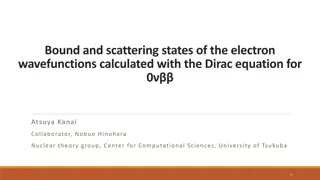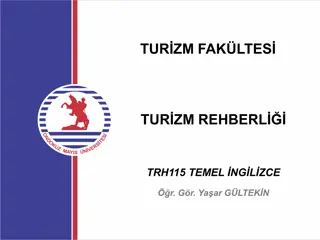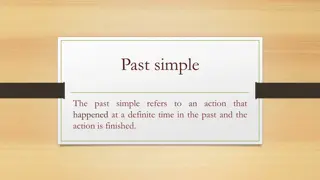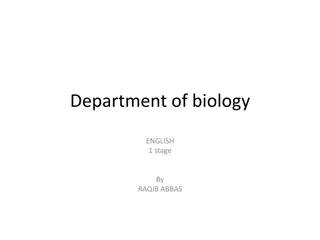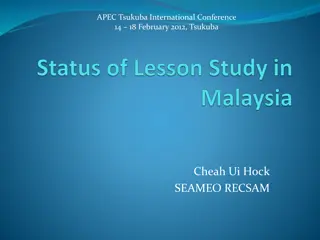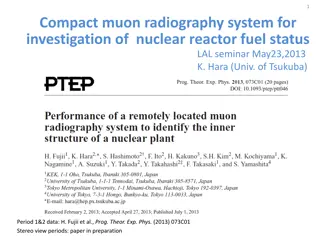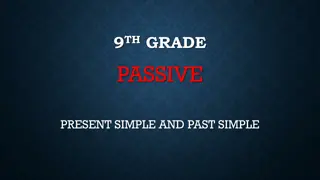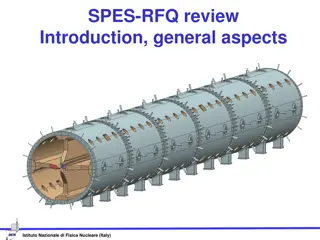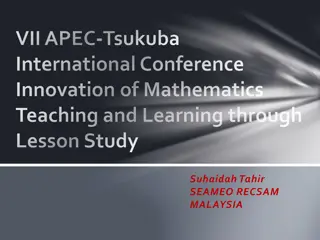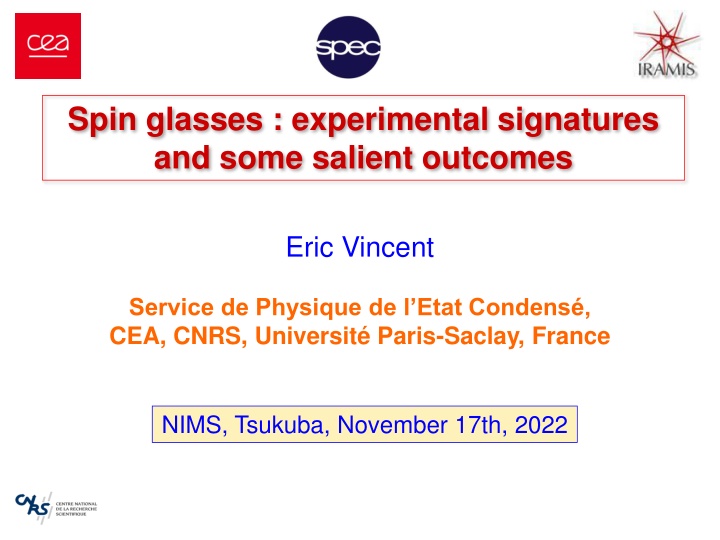
Spin Glasses: Experimental Signatures and Outcomes
Explore the intriguing world of spin glasses, including aging effects, memory phenomena, and correlation lengths of spin-glass orders. Discover the theory behind spin glasses, their magnetic properties, and the cluster-glass distinction in this comprehensive study.
Download Presentation

Please find below an Image/Link to download the presentation.
The content on the website is provided AS IS for your information and personal use only. It may not be sold, licensed, or shared on other websites without obtaining consent from the author. If you encounter any issues during the download, it is possible that the publisher has removed the file from their server.
You are allowed to download the files provided on this website for personal or commercial use, subject to the condition that they are used lawfully. All files are the property of their respective owners.
The content on the website is provided AS IS for your information and personal use only. It may not be sold, licensed, or shared on other websites without obtaining consent from the author.
E N D
Presentation Transcript
Spin glasses : experimental signatures and some salient outcomes Eric Vincent Service de Physique de l Etat Condens , CEA, CNRS, Universit Paris-Saclay, France NIMS, Tsukuba, November 17th, 2022
1. What is a spin glass ? 2. Aging, rejuvenation and memory effects 3. Correlation length of the spin-glass order
1. What is a spin glass ? 2. Aging, rejuvenation and memory effects 3. Correlation length of the spin-glass order
What is a spin glass ? Theory : random bonds H = - JijSi.Sj Jij gaussian, or J a disordered and frustrated magnetic system "Real" spin glasses : random dilution of magnetic ions Jij example: metallic alloys, Cu:Mn 3% RKKY interactions rij same generic behaviour in all samples (Tc 0 in 3d, slow dynamics, aging...) model disordered systems
Spin glass and cluster glass : the Au:Fe alloy Magnetic phase diagram of Au:Fe, from the 1993 book of J.A. Mydosh Comparison with strain glass and electric relaxor ? Xiaobing Ren : In the spin glass literature, spin glass is subdivided into two subsets: a dilute spin glass with nearly isolated and disordered spins being frozen, and a cluster spin glass with frozen nano- sized ferromagnetic domains or clusters. In the present article, we shall confine our discussion to cluster spin glass when mentioning spin glass, as it is physically parallel to strain glass and relaxor, both being cluster glasses. J.A. Mydosh : Hereby we can avoid, for the sake of simplicity, the mostly unnecessary distinction of having three or more spin-glass regimes
Magnetic properties of the CdCr2xIn2-2xS4compound Conflicting interactions between the Cr3+ Nearest neighbours : Ferro Next-nearest neighbours : Anti-Ferro Samples with various dilutions : (Marc Nogu s) x = 0.85, 0.90, 0.95 et 1.00 x=1.00-0.95 : Frustrated ferromagnet x=0.90 : Cluster glass x=0.85 : Spin glass Magnetization measurement procedures : ZFC = Zero-Field Cooling (open symbols) FC = Field Cooling (full symbols) Dupuis et al, EPJ B 29, 19 (2002)
Spin glass: general magnetic features ac susceptibility (frequency ) dc magnetization 0.08 FC para (~1/T) 0.06 3) M/H (emu/cm Tg( ) TRM 0.04 Tg CdCr1.7In0.3S4 ZFC 0.02 H=10G ZFC 0.00 0 5 10 15 20 25 30 35 40 T (K) Peak of : Tg( ) Spin freezing at time scale ~1/ FC Field-Cooled magnetization ZFC Zero-Field Cooled magnetization TRM Thermo-Remanent Magnetization ZFC(t)+TRM(t) = FC(t) Nordblad et al, JMMM 54, 185 (1986)
1. What is a spin glass ? 2. Aging, rejuvenation and memory effects 3. Correlation length of the spin-glass order
Spin glasses: slow dynamics + aging Uppsala (Lundgren, Nordblad) Saclay (Hammann, Ocio, Alba, Vincent) 80 Relaxation of theThermo-Remanent Magnetization (TRM) tw [min] 1000 0,14 CdCr1.7In0.3S4 T M = , ( f ) w t t 0,13 T g 300 0,12 T 100 m = M/MFC tw t 0,11 0,14 30 0,13 H 0,12 0,10 10 m = M/MFC 0,11 0,10 0,09 0 0,09 tw: waiting time t : observation time H : weak magnetic field 0,08 0,08 0,07 0,06 0,07 1E-4 1E-3 0,01 0,1 t/tw 1 10 100 T = 12 K = 0.7 Tg 0,06 0,1 1 10 100 1000 t [min] Non-stationary dynamics : (t , tw) Scaling variable : ~ t / tw (or t / tw with ~1)
Relaxation of the ZFC magnetization : aging effects T T 0.76 Fe0.5Mn0.5TiO3 H=5 Oe T=0.7Tg g 0.74 T 0.72 tw t MZFC/MFC 0.70 0.68 H 0.66 0 tw=300s tw=3000s tw=30000s 0.64 0.62 0.60 For longer tw, slower relaxation : aging 100 1000 temps (s) 10000 100000 dM / d log(t) The relaxing magnetization depends on both t and tw The relaxation rate dMtw/ d log t peaks around ti~ tw, defining a characteristic time tiin the relaxation process. 100 1000 10000 100000 t (s) Aging corresponds to the shift of tiwith tw
Aging, rejuvenation and memory: the simplest experiment Aging can also be observed in ac measurements : Relaxation of the ac susceptibility in a "negative temperature cycling" CdCr1.7In0.3S4 Tg=16.7K T t3 t1 t2 [a.u.] T g T = 12 K T T - T T- T= 10 K T = 12 K temps time [min] At constant T, relaxes (aging) T relaxation T : memory, no effect of the time spent at T- T : rejuvenation, restart of the Lefloch et al, Europhys. Lett. 18, 647 (1992) see references in arXiv:2208.00981
Rejuvenation and memory effects in the ZFC relaxation 2.20 Au:Fe 8% ZFC procedure with stops (Uppsala 2001) 2.00 FC 3] 1.80 3 [emu/cm 1.60 T 1.40 ZFC H = 50 Oe 1.20 T x 10 g fast cooling (100mK/s) 1.00 i=3600s, i=1,6) step cooling (tw slow cooling (4mK/s) 0.80 0.60 0 5 10 15 T [K] 20 25 30 H time 0.00 0 -0.02 [ Mstep-Mfast ] / Mfast Multiple memories can be stored -0.04 slow cooling step cooling Rejuvenation and memory effects now seen in numerical simulations ! Baity-Jesi et al (Janus collaboration), arXiv:2207.06207v2 -0.06 -0.08 Au:Fe 8% H = 50 Oe -0.10 V. Dupuis, PhD thesis, Orsay 2002 E.V., Lect. Notes Phys. 716, 7 (2007), or cond-mat/0603583 -0.12 0 5 10 15 20 25 30 T [K]
1. What is a spin glass ? 2. Aging, rejuvenation and memory effects 3. Correlation length of the spin-glass order
Aging growth of a local random order Fisher Huse droplet model idea (1988) Starting from a random state, aging can be viewed as the expansion of cooperative regions whose size defines a glassy coherence length . tw=2 Can we see such domains ? (Of how many types are they ?) tw=27 tw= 57797 grey scale = cos i(tw) = Sia(tw). Sib(tw)
Measuring the growth of the spin-glass order with time during aging In a ZFC relaxation curve : inflection point at ~ tW= characteristic time This time defines a typical free-energy barrier = kBT.Ln tW (Thermal activation : tW=exp( /kBT) ) -3 1.6x10 Fe0.5Mn0.5TiO3 tw=10000s Relaxation measurements for increasing field amplitudes : As H , the measured relaxations become faster Inflection point at tW tWeff (H) MZFC/H (u.a.) -3 1.5x10 eff tw -3 1.4x10 tw H=900 Oe H=5 Oe -3 1.3x10 The typical barrier is reduced to kBT.Ln tWeff(H) 100 1000 time (s) 10000 - After tw, cooperative regions have grown up to a size Ns(tW) - Idea (R. Orbach) : There is a Zeeman energy of coupling of H to the Ns(tW) correlated spins, Ez(H)= 1spin.Ns(tw).H2 , which lowers the barrier to kBT.Ln tWeff(H) = - EZ(H) . At fixed tw, measure EZ(H)= kBT.Ln tW /tWeff (H) obtain Ns(tW).
Growth of the number of correlated spins during aging : NS~ 104-106- from 5 different spin glasses NS ~ (tw/ 0)0.45 T/Tg 7 10 Heisenberg- like samples Y.G. Joh et al, PRL 82, 438 (1999) + Saclay new data 6 10 0.9 Tg Cu:Mn6% CdCr1.7In0.3S4(Saclay) CdCr1.7In0.3S4(UCR) Ag:Mn2.6% Fe0.5Mn0.5TiO3 L=(tw / 0) Ns Ising sample 5 10 Bert et al, Phys. Rev. Lett. 92, 167203 (2004) 0.7 Tg 0.153T/Tg 4 10 22 24 26 28 30 32 34 36 T/Tg ln(tw/ 0) Nsgrows up to ~106spins. If NS ~ 3, correlation length ~ 100 lattice units NS ~ (tw/ 0)0.45 T/Tg: extrapolation of the simulations ~overall agreement But : Ising spins, and computed from microscopic 4-point correlation function
Experiments and simulations : recent results (1) Massive simulations on the Janus II supercomputer ( Janus Collaboration ) Ising spins on a cubic lattice, size L=160, nearest-neighbour interactions (Edwards-Anderson model) many results Time going as far as 234=1010.6 MC steps (Experiments : t/ 0 =105/10-12=1017) The correlation length can now be determined following the experimental procedure (effect of increasing field values on the ZFC relaxation) Tg=1.10 This agrees with the one determined microscopically, validating the experimental protocol. Some differences are pointed out regarding the development of spin- glass order in a field, also found now in experiments. Several recent papers in common between experimentalists and numericians : See e.g. Paga et al arXiv:2207.10640v1, Janus Collaboration + Univ. of Texas + etc.
Experiments and simulations : recent results (2) New experiments on a single crystal of Cu:Mn, very close to Tg University of Texas at Austin - The correlation length almost reaches the macroscopic scale (150nm) - Still in agreement with the numerical simulations
Summary Spin glasses : random dilution of magnetic atoms (ions) in a non-magnetic matrix, disorder leading to frustration At higher concentrations : cluster glass . Maybe closer to strain glass and relaxor ? Does it make a big difference ? In the glassy phase : slow dynamics + aging effects T aging restarts, rejuvenation effect T back : memory of the previous state of aging Multiple rejuvenation and memory processes can be obtained Rejuvenation and memory now observed in numerical simulations Aging can be viewed as the expansion of cooperative regions whose size defines a glassy coherence length ( glassy order ). During aging, grows up to ~ 100-1000 lattice units (recent : 150nm) Numerical simulations (Janus Collaboration) now almost reach this scale (~20-25) Simulations show that from experimental methods coincides with the microscopic
New open ways Exploring the glassy order , in parallel with the present development of numerical simulations : Understanding the microscopic mechanism at play in rejuvenation and memory effects (Janus collaboration) Clarifying the nature of the spin-glass phase in a field (recent results on the failure of the superposition principle) Observing when the correlation length reaches the sample size in mesoscopic samples or thin films (Texas Univ., Orbach et al) Nature of the spin-glass transition for Heisenberg spins ? Is it driven the spin-chirality freezing ? (Kawamura 1992) measurements of the anomalous Hall effect (Starting : Pureur 2004,Taniguchi 2007 difficult) Two (ferro-like, droplet model) or many pure states (RSB-like) ? Measuring the Universal Conductance Fluctuations in mesoscopic samples (Carpentier 2008, Forestier 2020). Etc.

